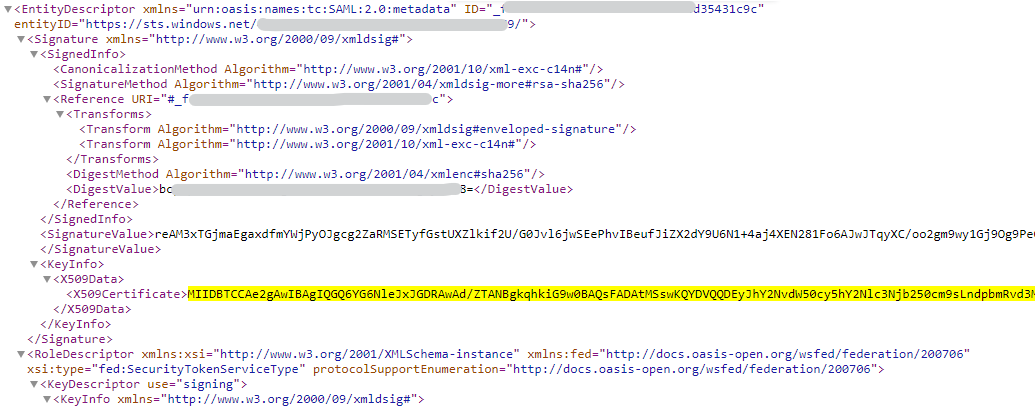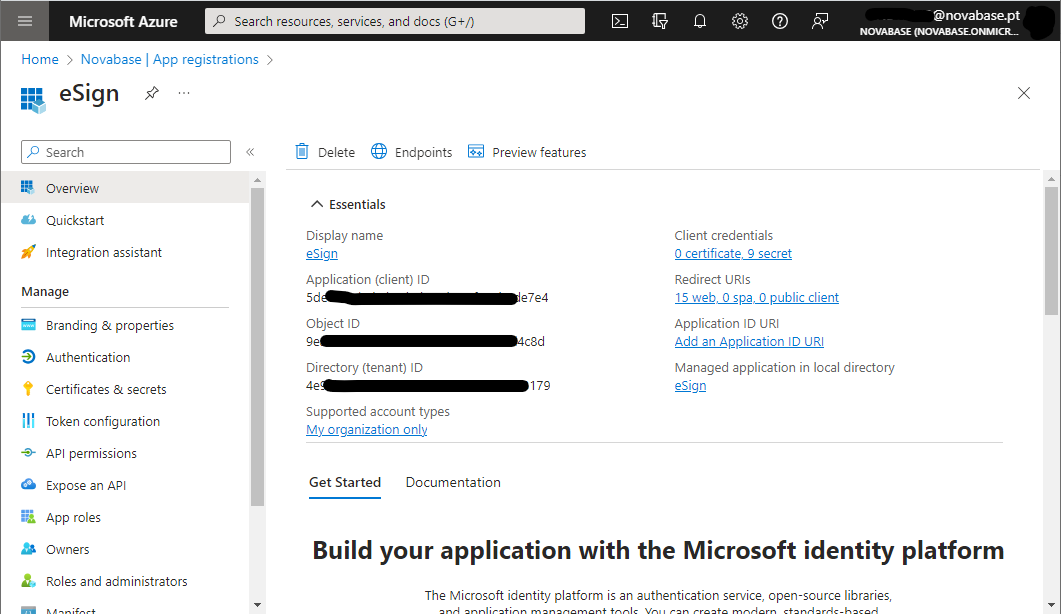Configuring SSO Authentication
eSign Portal login can be configured to integrate with a SAML2.0 IdP.
The entire configuration of this integration can be managed with environment variables in your deployment.
Enable/Disable SSO Authentication
SSO Authentication can be easily toggled on and off with the configuration below:
| Env Variable Name | Mandatory | Description | Default Value |
|---|---|---|---|
ESIGN_SSO_SAML_ENABLED |
false |
Determines if SSO login is enabled |
false |
| If you enable SSO SAML Authentication, the section below MUST be configured. |
Integration with SAML IdP
SSO Authentication can be easily toggled on and off with the configuration below:
Minimum mandatory configurations
| Env Variable Name | Mandatory | Description | Default Value |
|---|---|---|---|
ESIGN_SSO_SAML_ISSUER |
true |
The unique identifier of the issuer of the IdP. |
<null> |
ESIGN_SSO_SAML_IDP_URL |
true |
The login url of your IdP. |
<null> |
ESIGN_SSO_SAML_IDP_CERTIFICATE |
true |
The IdP’s certificate in BASE64, required to validate the signature of the SAML Response. |
<null> |
ESIGN_SSO_SAML_RESPONSEISSUER |
true |
The response issuer. Must match the value present in the "Issuer" element of the SAML Response. |
<null> |
If your IdP provider provides multiple signer certificates, you must add all of them in ESIGN_SSO_SAML_IDP_CERTIFICATE separated by commas (,).Otherwise the authentication will randomly fail when the IdP rotates the certificate. |
Additional configurations
| Env Variable Name | Mandatory | Description | Default Value |
|---|---|---|---|
ESIGN_SSO_SAML_IDP_KEY |
false |
The IdP key in BASE64 needed to decrypt the assertions (should the IdP be configured to return encrypted assertions) |
<null> |
ESIGN_SSO_SAML_SP_CERTIFICATE |
false |
Your own certificate key in BASE64. |
<null> |
ESIGN_SSO_SAML_SP_KEY |
false |
Your own private key in BASE64. |
<null> |
ESIGN_SSO_SAML_ATTR_USERNAME |
false |
Name of the attribute of the SAML response containing the username |
|
ESIGN_SSO_SAML_ATTR_FIRSTNAME |
false |
Name of the attribute of the SAML response containing the user first name |
http://schemas.xmlsoap.org/ws/2005/05/identity/claims/givenname |
ESIGN_SSO_SAML_ATTR_LASTNAME |
false |
Name of the attribute of the SAML response containing the user last name |
http://schemas.xmlsoap.org/ws/2005/05/identity/claims/surname |
ESIGN_SSO_SAML_ATTR_EMAIL |
false |
Name of the attribute of the SAML response containing the user email |
|
ESIGN_SSO_SAML_ATTR_ROLES |
false |
Name of the attribute of the SAML response containing the user roles (ex: http://schemas.microsoft.com/ws/2008/06/identity/claims/groups) |
<null> |
Advanced Configurations
Auto-Create Users
When SSO login is enabled, by default all users of your organization will have access to eSign Portal.
By default new users are automatically created and assign the default permission to view the analytics dashboard.
To change this behavior use the following configurations:
| Env Variable Name | Mandatory | Description | Default Value |
|---|---|---|---|
ESIGN_SSO_CREATE_USER_ENABLED |
false |
Automatically create a user entry in eSign Portal UAM DB when a new user successfully logs in with SSO. |
true |
ESIGN_SSO_CREATE_USER_ROLES |
false |
Assigns new users login in with SSO the on or more default roles (comma separated) |
Operator |
Whitelisting Users & Roles
It is possible to add criteria to prevent anyone with an SSO login to access eSign Portal.
For this purpose, it is possible to configure a whitelist of either usernames or roles.
Whitelisting Users
Set a configuration with a list of the usernames that are authorized to access eSign Portal.
The username must match the username retrieved from the SSO response.
| Env Variable Name | Mandatory | Description | Default Value |
|---|---|---|---|
ESIGN_SSO_WHITELIST_USERS |
false |
Whitelist of users authorized to access eSign Portal (comma separated) |
<null> |
Whitelisting Users
Set a configuration with a list of the roles that are authorized to access eSign Portal.
Pre-requirements:
-
The IdP must be configured to retrieve list of roles of the user in the response
-
The configuration
ESIGN_SSO_SAML_ATTR_ROLESlisted in Additional Configurations must be set to match the attribute of the SAML Response where the roles will be listed.
| Env Variable Name | Mandatory | Description | Default Value |
|---|---|---|---|
ESIGN_SSO_WHITELIST_ROLES |
false |
Whitelist of roles the user logging-in must have to access eSign Portal (comma separated) |
<null> |
Example: Integration with AzureAD
Below is an example of a heml chart override (overrides.yaml) configured to use AzureAD SAML.
conf:
env:
custom:
- name: ESIGN_SERVER_URL
value: https://my-esign.com
- name: ESIGN_SERVER_USERNAME
value: admin
- name: ESIGN_SERVER_PASSWORD
value: my_admin_pass
- name: ESIGN_SSO_SAML_ENABLED
value: true (1)
customFromCredentialSecret:
- name: ESIGN_SSO_SAML_ISSUER
key: ssoSamlIssuer
value: [your-app-id] (2)
- name: ESIGN_SSO_SAML_IDP_URL
key: ssoSamlIdpUrl
value: https://login.microsoftonline.com/[your-tenant-id]/saml2 (3)
- name: ESIGN_SSO_SAML_IDP_CERTIFICATE
key: ssoSamlIdpCert
value: MIIDBTCCAe2gAwIBAgIQGQ6YG6NleJxJGDRAwAd... (4)
- name: ESIGN_SSO_SAML_RESPONSEISSUER
key: ssoSamlRespIssuer
value: https://sts.windows.net/[your-tenant-id]/ (5)| 1 | Enables SSO SAML authentication |
| 2 | Your Azure Application (client) ID |
| 3 | Your Azure Tenant ID |
| 4 | Certificate of your Azure SAML provider. Can usually be retreived from: https ://login.microsoftonline.com/[your-tenant-id]/federationmetadata/2007-06/federationmetadata.xml 
|
You can check your Tenant ID and Application ID in Azure Portal
